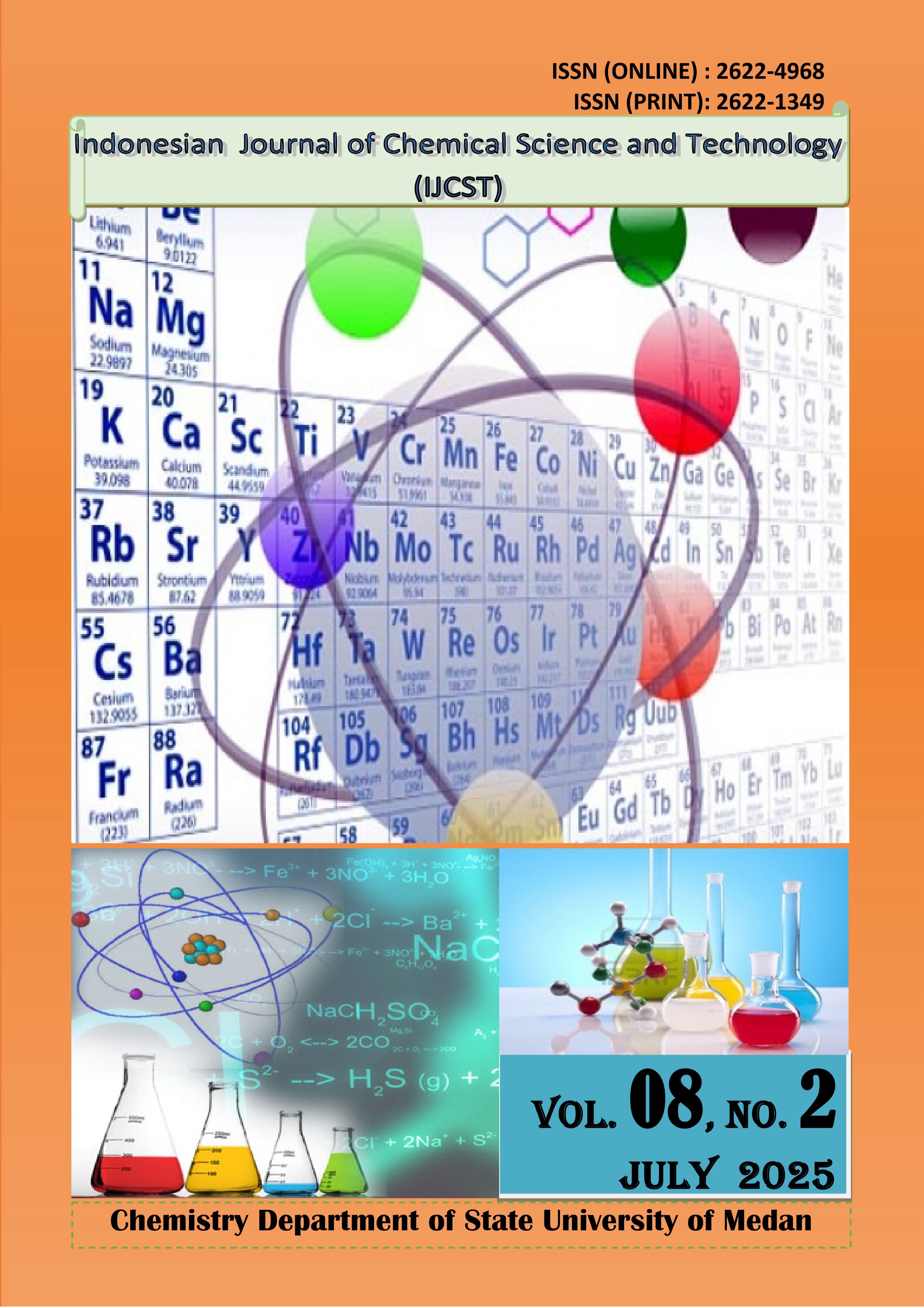Influence of Citric, Acetic, and Ascorbic Acids on the Solubility of Paracetamol
DOI:
https://doi.org/10.24114/ijcst.v8i2.68730Keywords:
Acetic acid, Ascorbic acid, Citric acid, Paracetamol, SolubilityAbstract
This study examined the influence of citric, acetic, and ascorbic acids on the solubility of paracetamol, an analgesic with inherently low aqueous solubility. Paracetamol tablets were dissolved in different concentrations of organic acid solutions, and dissolution times were visually monitored. The most rapid dissolution occurred in 30% acetic acid solution (190 seconds), followed by the citric–acetic acid mixture. Increasing paracetamol mass extended dissolution time, with saturation reached at 3.5 g. Enhanced solubility was attributed to hydrogen bonding interactions between organic acids and paracetamol molecules. Compared with complex techniques such as solid dispersions or co-amorphous systems, this acid-assisted approach is simple, low-cost, and requires no specialized equipment. These findings highlight the role of weak organic acids as practical solubility enhancers and suggest a promising strategy to improve paracetamol bioavailability and therapeutic effectiveness.References
1. He S, Mu H (2023) Microenvironmental pH Modification in Buccal/Sublingual Dosage Forms for Systemic Drug Delivery. Pharmaceutics 15, 637.
2. Almotairy A, Almutairi M, Althobaiti A, Alyahya M, Sarabu S, Alzahrani A, Zhang F, Bandari S, Repka MA (2021) Effect of pH modifiers on the solubility, dissolution rate, and stability of telmisartan solid dispersions produced by hot-melt extrusion technology. J Drug Deliv Sci Technol 65, 102674.
3. Lambros M, Tran T (Henry), Fei Q, Nicolaou M (2022) Citric Acid: A Multifunctional Pharmaceutical Excipient. Pharmaceutics 14, 972.
4. He S, Mu H (2023) Microenvironmental pH Modification in Buccal/Sublingual Dosage Forms for Systemic Drug Delivery. Pharmaceutics 15, 637.
5. Mercado SAS, Galvis DGV (2023) Paracetamol ecotoxicological bioassay using the bioindicators Lens culinaris Med. and Pisum sativum L. Environmental Science and Pollution Research 30, 61965–61976.
6. Chronowska M, Dressman J (2024) An In Vitro Model for Release of Acetaminophen When an Overdose is Ingested Orally. Dissolut Technol 31, 14–24.
7. He S, Østergaard J, Ashna M, Nielsen CU, Jacobsen J, Mu H (2020) Microenvironmental pH modifying films for buccal delivery of saquinavir: Effects of organic acids on pH and drug release in vitro. Int J Pharm 585, 119567.
8. Miotke-Wasilczyk M, Józefowicz M, Strankowska J, Kwela J (2021) The Role of Hydrogen Bonding in Paracetamol–Solvent and Paracetamol–Hydrogel Matrix Interactions. Materials 14, 1842.
9. Muzioł TM, Bronikowska E (2024) Driving Forces in the Formation of Paracetamol Cocrystals and Solvate with Naphthalene, Quinoline and Acridine. Molecules 29, 4437.
10. Mahmoud AAK, Regdon G, Kristó K (2025) Cutting-Edge Approaches in the Co-Amorphization Process. Pharmaceutics 17, 850.
11. Salehi N, Kuminek G, Al-Gousous J, Sperry DC, Greenwood DE, Waltz NM, Amidon GL, Ziff RM, Amidon GE (2021) Improving Dissolution Behavior and Oral Absorption of Drugs with pH-Dependent Solubility Using pH Modifiers: A Physiologically Realistic Mass Transport Analysis. Mol Pharm 18, 3326–3341.
12. He S, Østergaard J, Ashna M, Nielsen CU, Jacobsen J, Mu H (2020) Microenvironmental pH modifying films for buccal delivery of saquinavir: Effects of organic acids on pH and drug release in vitro. Int J Pharm 585, 119567.
13. Liu J, Grohganz H, Löbmann K, Rades T, Hempel N-J (2021) Co-Amorphous Drug Formulations in Numbers: Recent Advances in Co-Amorphous Drug Formulations with Focus on Co-Formability, Molar Ratio, Preparation Methods, Physical Stability, In Vitro and In Vivo Performance, and New Formulation Strategies. Pharmaceutics 13, 389.
14. Tarawneh OA, Madi AM, Hamed R, Qirem R, Qerem W, Alhusban A, Sunoqrot S, Mahmoud N, Ata S, Alsheikh I (2019) In vitro Characterization and Evaluation of Commercialized Paracetamol Products in Jordan. Dissolut Technol 26, 36–44.
15. Muzioł TM, Bronikowska E (2024) Driving Forces in the Formation of Paracetamol Cocrystals and Solvate with Naphthalene, Quinoline and Acridine. Molecules. https://doi.org/10.3390/molecules29184437
16. Anilkumar Shinde, Namdeo Jadhav, Ojas Shinde, Pravin Patil (2019) Enhancement Solubility And Dissolution Rate Of Paracetamol And Ibuprofen By Coamorphous Particles Using Microwave Technique. Asian Journal of Pharmaceutical and Clinical Research 155–162.














